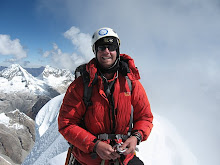Two days after summitting Alpamayo, we arrived at the trailhead at the village of Quechapampa at 5 p.m. Brad and I were worried about not finding a collectivo (inexpensive public bus) for the 3 hour ride to Huaraz. Brad was leaving for Lima the following day, so our urgency to get to Huaraz was hightened. Serendipidously at the trailhead, we met two French climbers hiking out behind us and who´s English and Spanish were as good as my French. Immediately I knew we needed to team with the French to gain a ride to Huaraz at a reasonable fare. Four seconds after meeting the French two taxi´s arrive, one from each direction on the one-lane dirt road that constitutes most of Quechapampa. Juxtiposition in the dirt road - 1 trailhead, 2 dirty Americans, 2 dirty French, 2 white identical Toyota Corolla taxis facing hood to hood, 2 taxi drivers (cabbies), 1 arriero (our burro driver) and 1 overloaded small burro, and 4 idling compensinos (local farmers). The negotiations began with the 12 of us huddled over the hood of a taxi - the cabbies argued 180 Soles, the Americans demanded no more than 80, the French discussed wtih each other and cajoled one cabbie on paper for a price for two to an intermediary village, the compensinos teased the cabbies about overcharging the gringos, the burro was tired, the cabbies were trying not to compete and lower the price, the arriero told the Americans it should cost 120, the Americans insisted the French to join them as a team of 4, the French were still negotiating a 2 person fare to the wrong village, the arriero smiled and laughed, the cabbies began to sweat, the Americans pretended to walk away in disgust, one cabbie broke down to 140 Soles, the Americans emphatically convinced the French that the 4 of us need to take the 140 - its a good deal!
Deal done, but the most dangerous part of the climb comes next. Four climbers and one taxi (all taxis in Peru are late 90s Toyota Corolla wagons with tiny tires) barrel down 4,000 veritcal feet of one-lane dirt road, winding and contouring along the mountain topography tailgating behind a dump truck! The dust behind the truck formed an urban whiteout but the taxi continued to tailgate and honk his horn every 3 seconds signalling his desire to pass. With dust all over the inside of the car and our faces, I had the terrifiying position of sitting in the front seat! Finally passing the truck, the cab continued to race around blind corners honking to alert potential on-coming traffic on the one-lane dirt road. Sitting shotgun, I witnessed the narrow calculated misses of dogs, potholes, other taxis, grandmothers, and children. With each close pass, the cabbie gave a strong 3 toots of the horn. It was a tense 3 hour ride.
Maybe this is why I climb.
-Chris
 |
| Alpamayo - French Direct |


No comments:
Post a Comment